 Last additions - IBARAKI 茨城県 Last additions - IBARAKI 茨城県 |
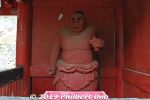
Romon GateMar 22, 2019
|
|
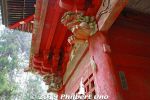
Romon GateMar 22, 2019
|
|
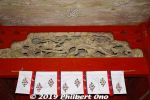
Romon GateMar 22, 2019
|
|

Romon GateMar 22, 2019
|
|
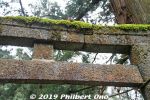
ToriiMar 22, 2019
|
|
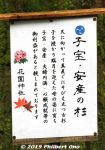
About the pregnant tree. This tree's male partner and due date are unknown.Mar 22, 2019
|
|
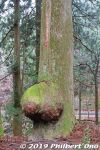
In Kita-Ibaraki, Hanazono Shrine's pregnant tree, now an object of worship for wannabe mothers and pregnant mothers for a safe childbirth. Near the first torii.Mar 22, 2019
|
|
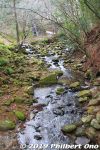
Hanazono Gorge, a major tourist spot in Kita-Ibaraki.Mar 22, 2019
|
|
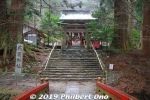
Hanazono Shrine (花園神社) is in the scenic Hanazono Gorge in the mountainous interior of the city. It's not related to Hanazono Shrine in Shinjuku, Tokyo, but it's related to Hie Shrine in Akasaka.It belongs to the same family of Shinto shrines worshipping the mountain deity Sanno (山王) headquartered at Hiyoshi Taisha Shrine at the foot of Mt. Hiei in Shiga Prefecture. Mar 22, 2019
|
|

An-chan and Kou-chan mascots in Aloha shirts.Mar 22, 2019
|
|
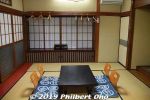
Standard size room in Minshuku Uohiko.Mar 22, 2019
|
|
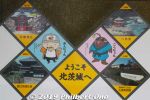
JR Isohara Station welcome sign.Mar 22, 2019
|
|
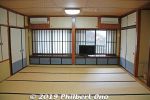
Large room in Minshuku Uohiko.Mar 22, 2019
|
|
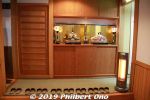
Minshuku Uohiko uses natural hot spring for the bath.Mar 22, 2019
|
|
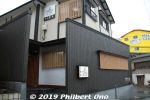
Onsen Minshuku Uohiko lodge near Hirakata Port. Ankou-nabe is a specialty. Recently renovated. 温泉民宿 魚彦Mar 22, 2019
|
|
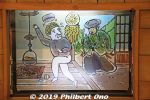
However, the 12 whalers were instead held captive by the local samurai. They were tied to plum trees or confined to caves. More British ships arrived seeking the release of the prisoners.Also, the Mito Clan also brought in neighboring clans like the Taira Clan as reinforcement for a potential battle. Cannons were pointed at each other, but a conflict was averted by giving the whalers the water and food that sent them along their way away from Japan. In return, the whalers gave guns, spears, felt, gold, and silver as payment and had to promise not to approach Japan again.Mar 22, 2019
|
|
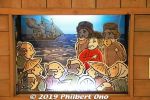
The crew suffered from scurvy due to the lack of vitamin C. They needed water and vegetables so 12 British whalers landed on Otsuhama beach in Kita-Ibaraki. They were willing to barter guns, spears, gold, etc., as payment. (大津浜事件) Mar 22, 2019
|
|
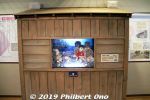
Yo-soro Museum also has this kami-shibai storytelling room. Story about British whalers who landed on Otsuhama beach in Kita-Ibaraki in May 1824 in search of food and water.It was during the time Japan largely prohibited contact with foreigners. By the 1800s, whaling ships from the West were frequently seen off the coast of Japan. In May 1824, multiple British whaling ships appeared off the coast of Kita-Ibaraki.Mar 22, 2019
|
|

The museum also has display panels showing the tsunami damage suffered by Kita-Ibaraki. Ibaraki Prefecture, being on the southern fringe of the Tohoku Region, suffered major earthquake and tsunami damage in March 2011.Kita-Ibaraki being closest to the Tohoku Region on the coast, suffered the most in Ibaraki Prefecture. The flat sandy beaches were overcome by the tsunami (second wave around 5 meters high) that caused much damage to Kita-Ibaraki. This is the Hirakata area after the tsunami. Besides major damage along the coast, the interior areas had numerous landslides, collapsed walls, and damaged roads due to the quake. Mar 22, 2019
|
|
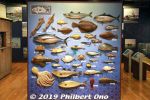
Display of all the fishes caught in Kita-Ibaraki.Mar 22, 2019
|
|

Ten people in Kita-Ibaraki died directly or indirectly due to the tsunami/earthquake and 186 injured. Over 8,000 homes in Kita-Ibaraki were damaged and up to 5,000 people had to evacuate to emergency shelters.These numbers pale in comparison to the three Tohoku prefectures, so Ibaraki doesn't get much attention with regard to 3-11, although the Emperor and Empress did visit Kita-Ibaraki in late April 2011.Mar 22, 2019
|
|

The boat, with shrine priests and musicians aboard, is rocked side to side as it is dragged on the street for several hours. This festival will be held on May 2nd–3rd, 2019. At least 160,000 spectators are expected to see it. Mar 22, 2019
|
|
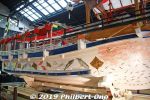
About 500 people drag this boat along a 1,200-meter route of paved streets. They lay wooden beams on the road for the boat to traverse on. Mar 22, 2019
|
|
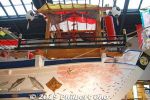
It's the city's grandest festival and very unique because this boat is pulled on city streets instead of sailing on the water. Mar 22, 2019
|
|
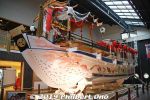
In Kita-Ibaraki, the Yo-soro Fishing History Museum's centerpiece exhibit is this wooden boat (祭事船) used in the Hitachi-Otsu Ofune Matsuri boat festival held every 5 years (常陸大津御船祭り). Mar 22, 2019
|
|
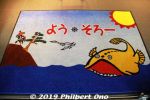
Welcome mat saying "Yo-soro" which means "Go ahead" for boat navigation.Mar 22, 2019
|
|
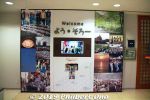
Yo-soro Fishing History Museum, 5 min. by taxi from JR Otsuko Station. Pretty large facility with local fishing-related exhibits. 北茨城市漁業歴史 資料館「よう・そろー」Mar 22, 2019
|
|

Akatsukien onsen minshuku dining room where we had monkfish hot pot. ¥14,000/night including dobujiru. 民宿 暁園Mar 22, 2019
|
|

This is monkfish hot pot (dobojiru ankou-nabe) どぶ汁 with monkfish parts in a miso broth. I didn't have any problem eating it. The flavor was certainly not objectionable, it's just another kind of fish.It was already prepared for us and it wasn't the fish we saw carved. Mar 22, 2019
|
|

The white meat of monkfish.Mar 22, 2019
|
|
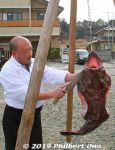
Monkfish being skinned and carved up by an expert chef. Since the monkfish is too slimy and slippery on a cutting board, it is hung like this for carving. It's a lot easier to cut up this way.He first takes off the skin (loaded with collagen).Mar 22, 2019
|
|
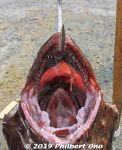
Look into the big mouth and see another set of teeth on the throat. All the teeth are pointed inward so its pray cannot escape. Like the aliens in the movie "Alien."Mar 22, 2019
|
|
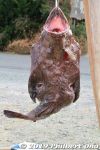
It's Kita-Ibaraki's famous fish and delicacy, monkfish, in the flesh. This one is 5 or 6 years old, weighing 12.7 kg. Only the female monkfish is eaten. The males are too small.あんこうMar 22, 2019
|
|
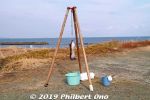
Oh look, something's hanging there...Mar 22, 2019
|
|

Cleaning up the fishing boat. Bycatch dumped overboard, but the birds are not picking it up.Mar 22, 2019
|
|
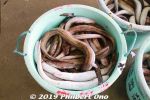
Sea eels or anago.Mar 22, 2019
|
|
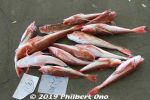
Mar 22, 2019
|
|

Mar 22, 2019
|
|

Each pile of fish is for a single bid.Mar 22, 2019
|
|
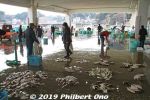
Besides monkfish, other fishes are sold at auction. This is not yet a tourist attraction since we were the only outsiders there.Mar 22, 2019
|
|

There are many species of angler fish in the world. The one caught in Japan is this one, Lophiomus setigerus.Monkfish has a big head, wide mouth, and a lure on the forehead to attract small fish. Looks kind of grotesque and lives on the ocean floor.Mar 22, 2019
|
|

Monkfish/goosefish (あんこう), a type of anglerfish. They are most prized for their liver (ankimo), a local delicacy.Mar 22, 2019
|
|

Hirakata Port's main catch is the monkfish/goosefish (あんこう), a type of anglerfish. Ibaraki Prefecture's coast is one of Japan's prime areas for monkfish. These are all monkfish being auctioned in the afternoon. 平潟港 せり見�Mar 22, 2019
|
|

It's unlike the old Tsukiji fish market or the new Toyosu Market in Tokyo.Mar 22, 2019
|
|

Hirakata Port has a fish market that holds a fish auction in the afternoon. This is a typical wholesale fish market in Japan. Open-air, flat roof with a concrete floor next to fishing boats. Mar 22, 2019
|
|
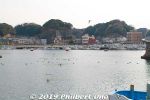
Hirakata Port is a major fishing port in Kita-Ibaraki.Mar 22, 2019
|
|

Our dorayaki teacher and Tengokoro store manager.Mar 22, 2019
|
|

The final step is to spread some azuki bean paste on one side and compress it into a sandwich. Way more delicious than any dorayaki you buy in a store.Mar 22, 2019
|
|
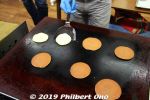
Dorayaki is like a small pancake sandwich with azuki bean paste in between. Wait until the batter bubbles and flip it over. Perfect each time. The dorayaki batter is very different from pancake batter.Mar 22, 2019
|
|
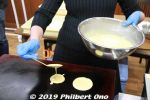
At Tengokoro, you can make your own dorayaki with azuki bean paste. The shallow ladle contains the perfect amount of batter to make one pancake. Mar 22, 2019
|
|
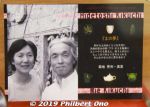
Kikuchi Hidetoshi and wife Mie.Mar 22, 2019
|
|
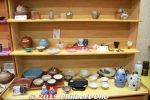
Pottery by our teacher, Kikuchi Hidetoshi and wife Mie.Mar 22, 2019
|
|
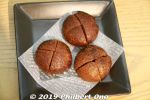
Karinto manju from Kita-Ibaraki.Mar 22, 2019
|
|
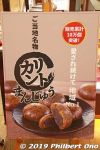
Karinto manju.Mar 22, 2019
|
|

An-chan on a cup of sake.Mar 22, 2019
|
|
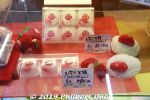
Strawberry daifuku is a specialty of Kita-Ibaraki. Made with locally-grown strawberries. Ibaraki is also a major producer of melons in Japan.Mar 22, 2019
|
|
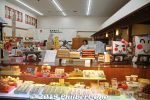
Inside Tengokoro.Mar 22, 2019
|
|
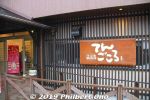
Tengokoro, for local gifts and products. てんごころ http://www.tengokoro.com/Mar 22, 2019
|
|
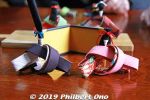
Very simple to make. Tie the two bands into a knot, then stick the head (pin) into it. Did it in 2 minutes. Prince on the left, princess on the right.Mar 22, 2019
|
|
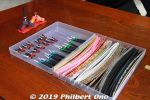
They taught us how to make Hina ningyo dolls for Girl's Day (March 3). We could pick any of these plastic pins and decorative bands for our Hina dolls. Yes, that's all we needed to make the dolls.Mar 22, 2019
|
|
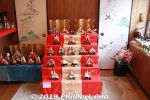
The gallery had Hina dolls for Girl's Day.Mar 22, 2019
|
|
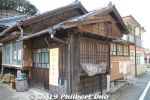
Gallery Salamat Po. "Salamat Po" means "Thank you" in Tagalog. (ぎゃらりー さらま・ぽ) (ぎゃらりー さらま・ぽ)Mar 22, 2019
|
|
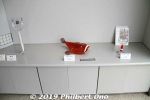
Glass Studio Silica with a glass sculpture of monkfish.Mar 22, 2019
|
|

Glass Studio Silica main exhibition room. ガラス工房シリカMar 22, 2019
|
|
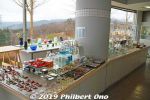
Glass Studio Silica gift shop. ガラス工房シリカMar 22, 2019
|
|
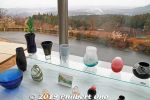
Silica Glass Museum is on a hill with great views of the city. Also offers hands-on glass-making lessons. http://www.studiosilica.com/Mar 22, 2019
|
|
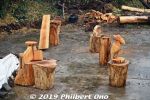
Chain saw sculptures.Mar 22, 2019
|
|
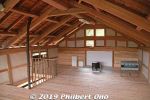
Former horse stable's attic will become a gallery space.Mar 22, 2019
|
|
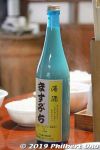
Local sake, a type called Doboroku (どぶろく) or nigori-zake (濁り酒). It's thick and cloudy-white. Sour taste. Made by a local brewer and restaurant named Masubuchi (増渕魚園).Mar 22, 2019
|
|
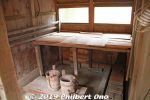
Former horse stable.Mar 22, 2019
|
|

Our table for lunch in the main room of Arigatee.Mar 22, 2019
|
|
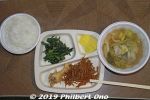
Our lunch at Arigatee. Chicken drumstick, vegetables, rice, and tonjiru (pork and vegetables) soup.Mar 22, 2019
|
|
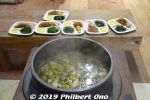
The miso soybean paste in the tonjiru pork miso soup was made by Sumi-chan, a "miso meijin" (味噌名人) or expert miso cook. Mar 22, 2019
|
|

Ishiwata Chifumi and Sumi-chan.Mar 22, 2019
|
|
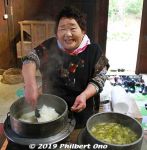
At Arigatee, we were charmed by the delightful Sumi-chan, a retired local farmer. She helped cook our lunch. Rice locally grown in Kita-Ibaraki. Thank you Sumi-chan for smiling!Mar 22, 2019
|
|

Arigatee's current caretaker is Ishiwata Norio and his wife Chifumi (石渡のりお・ちふみ). They moved here from Tokyo. He uses it as a artist studio. That's his painting on the wall.Kita-Ibaraki is promoting itself as an art city, and Arigatee is part of the project. Ishiwata-san and his wife were very gracious and a real boon to the city's artist community.Mar 22, 2019
|
|
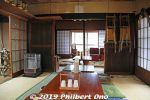
Arigatee is 150 years old built in the late Edo Period. This house will be accepting artist-in-residence as well.Mar 22, 2019
|
|
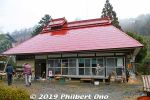
Former farmhouse converted into an artist's studio and gallery called "Arigatee" (pronounced "Ariga-tay" ありがてえ). It means "thankful" (arigatai) in the local dialect. It's also named after the former owner Mar 22, 2019
|
|

We were treated to refreshments served in the Kikuchis' pottery. Confection of azuki bean soup with a piece of mochi. Thank you to Hidetoshi and Mie Kikuchi (菊池 秀利・美恵) for teaching us pottery and hosting us in their beautiful, Japanese-Mar 22, 2019
|
|
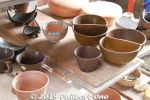
Kikuchi's pottery.Mar 22, 2019
|
|
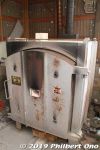
Kiln is in a another small building.Mar 22, 2019
|
|
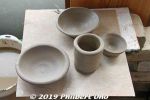
From one clump of clay, I made all these pieces. Oh yeah, it's easy. Anybody can do it. It costs a few thousand yen per piece to color and fire. It is sent to us later.Mar 22, 2019
|
|
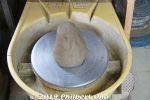
We each got a clump of clay, enough to make several cups or bowls.Mar 22, 2019
|
|
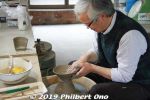
We visited his modest studio for a hands-on pottery lesson. First he demonstrated what we have to do. He made it look so quick and easy. 土の夢陶房 (菊池 秀利・美恵)Mar 22, 2019
|
|
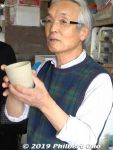
This is Kikuchi Hidetoshi, a local potter who, along with his wife Mie, taught us how to make Izura Tenshin-yaki pottery (五浦天心焼). They moved here in 1998.The Kikuchis are one of several Tenshin-yaki potters in Kita-Ibaraki.Mar 22, 2019
|
|
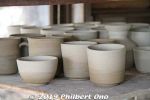
Local pottery called Izura Tenshin-yaki started about 25 years ago by the local Chamber of Commerce. Clay called "gairome" (蛙目) found locally is used. The clay is found in this area under the coal deposits. They collect the clay already exposed on the ground (no digging). This type of clay contains quartz, but the large quartz pieces are removed for pottery.Mar 22, 2019
|
|

My video of Matsuri Tsukuba and the Nebuta parade.Dec 31, 2011
|
|

Torii to Tsukuba-san Jinja ShrineNov 22, 2009
|
|
|
|

When I was there, a helicopter hovered about Mt. Nantai to rescue an injured hiker. I took a bus back to Tsukuba Station.Nov 22, 2009
|
|

Gate to Tsukuba-san Jinja Shrine's Haiden HallNov 22, 2009
|
|

Nov 22, 2009
|
|

Nov 22, 2009
|
|

Nov 22, 2009
|
|

Nov 22, 2009
|
|

Depicting Mt. Tsukuba.Nov 22, 2009
|
|

Nov 22, 2009
|
|

In autumn, a chrysanthemum display is held on the grounds of Tsukuba-san Shrine.Nov 22, 2009
|
|

Nov 22, 2009
|
|

Nov 22, 2009
|
|

Tsukuba-san Jinja Shrine's Haiden Hall is adjacent to the cable car station. The Honden Hall is atop the two peaks on Mt. Tsukuba. 筑波山神社Nov 22, 2009
|
|

Tsukuba-san Jinja Shrine's Haiden Hall. The shrine is dedicated to both Izanagi and Izanami, Japan's parent gods.Nov 22, 2009
|
|

Nov 22, 2009
|
|

Nov 22, 2009
|
|

Nov 22, 2009
|
|

Nov 22, 2009
|
|

Nov 22, 2009
|
|

Autmun maple leaves on Mt. Tsukuba-san.Nov 22, 2009
|
|

Nov 22, 2009
|
|

Nov 22, 2009
|
|

Nov 22, 2009
|
|

Nov 22, 2009
|
|

Around the cable car station below the mountain, the fall leaves were very nice.Nov 22, 2009
|
|

Nov 22, 2009
|
|

Entrance to Tsukuba-san cable car station.Nov 22, 2009
|
|

Bottom cable car station.Nov 22, 2009
|
|

Tsukuba-san cable car on Mt. Tsukuba's Miyukigahara, near Nantai.Nov 22, 2009
|
|

Cable car going up to Mt. Nantai on Mt. Tsukuba.Nov 22, 2009
|
|

The cable car runs every 20 min. Fare is 570 yen one way. There are trails going down the mountain as well.Nov 22, 2009
|
|

Miyukigahara also has a cable car station.Nov 22, 2009
|
|

View from Mt. Nantai on Tsukuba-san.Nov 22, 2009
|
|

Nov 22, 2009
|
|

This is one of them.Nov 22, 2009
|
|
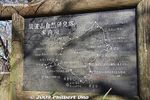
Hiking trail around Mt. Nantai. There are two other lookout points along the trail.Nov 22, 2009
|
|

On Nantai, there's an easy hiking trail going around the peak.Nov 22, 2009
|
|

Nov 22, 2009
|
|

Nov 22, 2009
|
|

Ropeway station on Mt. Nyotai.Nov 22, 2009
|
|

View from Mt. Nantai on Mt. Tsukuba.Nov 22, 2009
|
|

Mt. Nyotai as seen from Mt. Nantai on Mt. Tsukuba.Nov 22, 2009
|
|

Tsukuba-san Jjinja Shrine atop Mt. Nantai on Mt. Tsukuba. This is the Honden for the male god Izanagi.Nov 22, 2009
|
|

View from Mt. Nantai on Mt. Tsukuba.Nov 22, 2009
|
|

Shrine atop Mt. Nantai on Mt. Tsukuba.Nov 22, 2009
|
|

Mt. Nantai marker for 871 meter elevation.Nov 22, 2009
|
|

The trail soon gets steep and rocky, but not a problem for most people. High heels and miniskirt are not recommended.Nov 22, 2009
|
|

Nov 22, 2009
|
|
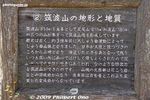
About Mt. Tsukuba's geology in Japanese.Nov 22, 2009
|
|

Mt. NantaiNov 22, 2009
|
|

Trail to climb up to Mt. Nantai.Nov 22, 2009
|
|

View from Miyukigahara.Nov 22, 2009
|
|

Nov 22, 2009
|
|

Nov 22, 2009
|
|

Looking toward Nyotai from Miyukigahara.Nov 22, 2009
|
|

Miyukigahara.Nov 22, 2009
|
|

Tsukuba-san Shrine on Mt. Nantai, the male peak.Nov 22, 2009
|
|

View from Miyukigahara.Nov 22, 2009
|
|

View from Miyukigahara.Nov 22, 2009
|
|

The round building has a gift shop on the bottom, restaurant on the 2nd floor, and a revolving lookout deck on the roof (free admission).Nov 22, 2009
|
|

Between Mt. Nyotai and Nantai on Mt. Tsukuba is a row of tourist shops in this palce called Miyukigahara (御幸ケ原). That's Mt. Nantai in the background.Nov 22, 2009
|
|

The trail continues to a clearing in the middle of the two peaks.Nov 22, 2009
|
|

Nov 22, 2009
|
|

Nov 22, 2009
|
|

From Mt. Nyotai, it's an easy hike but rocky trail to Mt. Nantai.Nov 22, 2009
|
|

Rock formation called Gama-ishi. ガマ石Nov 22, 2009
|
|

Nov 22, 2009
|
|

Nov 22, 2009
|
|

Tsutsujigaoka Ropeway Station below, as seen from the summit of Mt. Nyotai on Mt. Tsukuba.Nov 22, 2009
|
|

Nov 22, 2009
|
|

Nov 22, 2009
|
|

Views from the summit of Mt. Nyotai on Mt. Tsukuba.Nov 22, 2009
|
|

Atop the summit of Mt. Nyotai on Mt. Tsukuba.Nov 22, 2009
|
|

People climbing on the narrow peak of Nyotai. Mt. Tsukuba is one of Japan's 100 Famous Peaks.Nov 22, 2009
|
|

Tsukuba-san Jinja Shrine's Nyotai Honden on Mt. Nyotai. It worships Izanami, wife of Izanagi.Nov 22, 2009
|
|

Climbing up the peak of Mt. Nyotai.Nov 22, 2009
|
|

In the middle of the two peaks is another lookout deck and gift shops.Nov 22, 2009
|
|

View from Mt. Nyotai.Nov 22, 2009
|
|

Mt. Nantai in the distance.Nov 22, 2009
|
|

Mt. Fuji as seen from Mt. Nyotai.Nov 22, 2009
|
|

View from Mt. Nyotai.Nov 22, 2009
|
|

Lookout deck on Mt. Nyotai on Mt. Tsukuba.Nov 22, 2009
|
|

It's possible to climb up to Mt. Nyotai as well.Nov 22, 2009
|
|

Approaching Mt. Nyotai. Mt. Tsukuba is noted for fall leaves. But I was a little too late. The leaves here turn color earlier than on the plains. 女体山Nov 22, 2009
|
|

The ropeway runs every 20 min. The fare is 600 yen one way.Nov 22, 2009
|
|

I got off the bus at Tsutsujigaoka, the last stop. I hiked it from Mt. Nyotai (female peak) to Mt. Nantai (male peak). It's also possible to do it in the opposite direction from Nantai to Nyotai. つつじヶ丘Nov 22, 2009
|
|

Tsutsujigaoka has a ropeway aerial tram terminal taking you up to Mt. Nyotai, Mt. Tsukuba's female peak. 女体山Nov 22, 2009
|
|

Getting to Mt. Tsukuba is easy by bus from Tsukuba Station's Tsukuba Center Bus Terminal. Tsukuba-san Shuttle buses going directly to Mt. Tsukuba leave every 30 min. on weekends or every hour during weekdays and non-peak hours.Nov 22, 2009
|
|

Mt. Tsukuba has two peaks, Mt. Nantai (male peak) on the left and Mt. Nyotai (female peak) on the right. They are wedded peaks due to the wedded gods Izanami and Izanagi. 男体山 女体山Nov 22, 2009
|
|

Mt. Tsukuba ahead. It takes about 50 min. to reach Mt. Tsukuba by bus from Tsukuba Center Bus Terminal.Nov 22, 2009
|
|

Map of central Tsukuba.Aug 31, 2009
|
|

Matsuri Tsukuba postersAug 31, 2009
|
|

Rear view has a sleeping cat.Aug 31, 2009
|
|

Nebuta face-off.Aug 31, 2009
|
|

HanetoAug 31, 2009
|
|

For the finale, all the giant nebuta gathered at the large intersection. They didn't do much.Aug 31, 2009
|
|
|
|

Aug 31, 2009
|
|

Without the plastic covering.Aug 31, 2009
|
|

And other musicians.Aug 31, 2009
|
|

Each giant nebuta float is preceded by a set of drums and drummers.Aug 31, 2009
|
|

At the very end, despite the rain, they took off the vinyl.Aug 31, 2009
|
|

Rear view of Ramses IIAug 31, 2009
|
|

Aug 31, 2009
|
|

Ramses IIAug 31, 2009
|
|

Rear view.Aug 31, 2009
|
|

Aug 31, 2009
|
|

Aug 31, 2009
|
|

Too bad the plastic was on the floats. Aug 31, 2009
|
|

Aug 31, 2009
|
|

The slayed dragon exhaled smoke.Aug 31, 2009
|
|

Poor dragonAug 31, 2009
|
|

Quite dramatic indeed.Aug 31, 2009
|
|

At first, I thought it looked kind of gimmicky, comical, and fake, but it turned out to be quite impressive.Aug 31, 2009
|
|

This small float by local Boy Scouts.Aug 31, 2009
|
|

The inflated nebuta comes around.Aug 31, 2009
|
|

This float by a junior high school.Aug 31, 2009
|
|

Aug 31, 2009
|
|

Kids dancingAug 31, 2009
|
|

HanetoAug 31, 2009
|
|

Aug 31, 2009
|
|

Hayashi festival musicAug 31, 2009
|
|

Aug 31, 2009
|
|

Another one squeezes through. Aug 31, 2009
|
|

Aug 31, 2009
|
|

Being inflated now.Aug 31, 2009
|
|

Almost fully inflated.Aug 31, 2009
|
|

Haneto dancers. Much fewer of them than in Aomori.Aug 31, 2009
|
|

The first big one squeezes under the bridge. Aug 31, 2009
|
|

Aug 31, 2009
|
|

At first glance, it looks very strange. But they soon inflated it.Aug 31, 2009
|
|

The floats were covered with plastic due to drizzling rain.Aug 31, 2009
|
|

At 5 pm, the Nebuta Parade started. It was kind of strange to see a nebuta parade in almost broad daylight. Aug 31, 2009
|
|

Banpaku FloatAug 31, 2009
|
|

Aug 31, 2009
|
|

The mikoshi goes to meet the float.Aug 31, 2009
|
|

Then came this giant mikoshi portable shrine called the Tsukuba Manto Mikoshi. It doesn't seem to belong to any shrine. つくば万灯神輿Aug 31, 2009
|
|

Aug 31, 2009
|
|

Aug 31, 2009
|
|

万博山車パレードAug 31, 2009
|
|

The fourth giant nebuta was perhaps the most unique. It was made of inflatable vinyl. It is partially deflated here.Aug 31, 2009
|
|

From about 4 pm, they had the Matsuri Parade on the main road. まつりパレード 万博山車パレードAug 31, 2009
|
|

Aug 31, 2009
|
|

Inside the nebuta tent.Aug 31, 2009
|
|

A third giant nebuta depicts the Pharaoh Ramses II. Seeing an Egyptian theme on a Japanese float was interesting.Aug 31, 2009
|
|

Aug 31, 2009
|
|

Aug 31, 2009
|
|

Another giant nebuta float.Aug 31, 2009
|
|

Monkey's underarm has patch-up work.Aug 31, 2009
|
|

Aug 31, 2009
|
|

Aug 31, 2009
|
|

Aug 31, 2009
|
|

Patching up the damaged parts of the float. Apparently, it got damaged as it passed under a bridge that is a little too low for the giant nebuta.Aug 31, 2009
|
|

Inside the nebuta tent was this nebuta float from Aomori, arrived earlier in Aug.Aug 31, 2009
|
|

The nebuta tents were built in late July. No kids around sketching the nebuta though, as they do in Aomori during the day.Aug 31, 2009
|
|

In Oshimizu Park were these nebuta tents where they store the nebuta floats. 大清水公演Aug 31, 2009
|
|

Walking further down the Tsukuba Koen-dori road toward Oshimizu Park.Aug 31, 2009
|
|

A nice elevated walkway connected Chuo Park and the main festival area.Aug 31, 2009
|
|

Street performersAug 31, 2009
|
|

Chuo Park bazaarAug 31, 2009
|
|

Street performer (Sign says, "Photography allowed.")Aug 31, 2009
|
|

Kabuki-like magician.Aug 31, 2009
|
|

The program was called Happy Hawaiian Stage. ハッピーハワイアンステージAug 31, 2009
|
|

Another venue in Creo Square was this small outdoor stage featuring hula dancing all afternoon long by various groups. クレオ前広場Aug 31, 2009
|
|
|
|